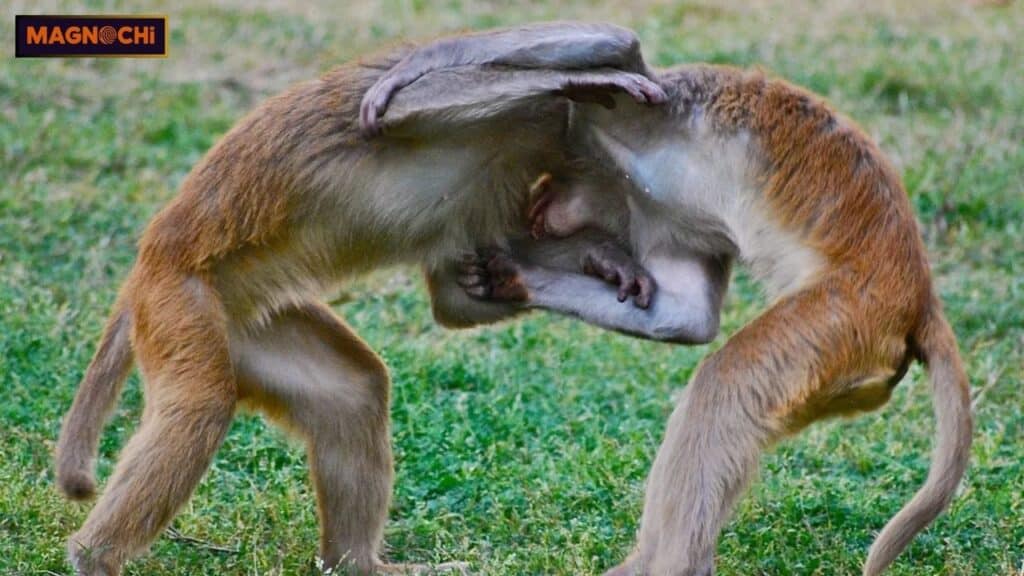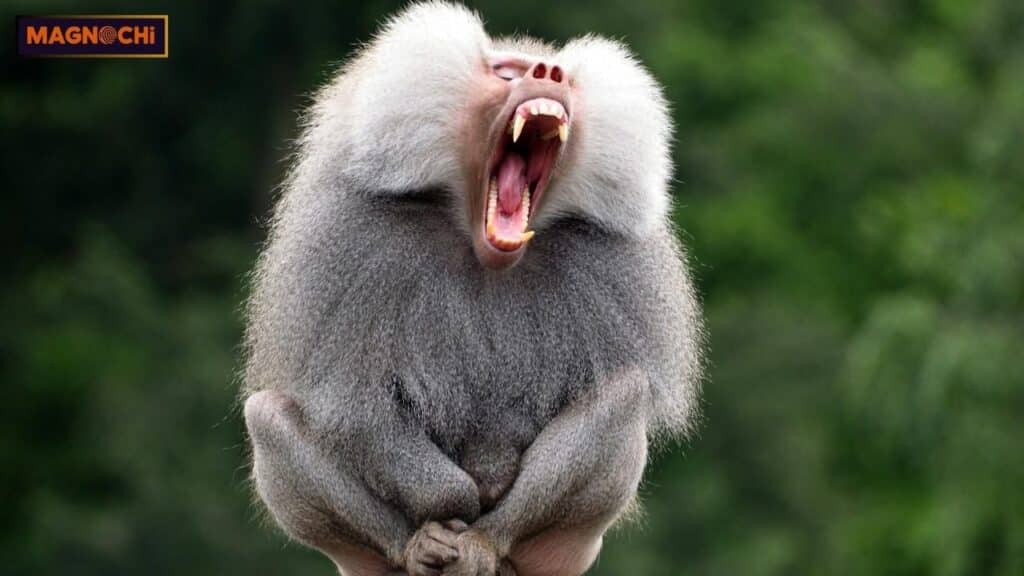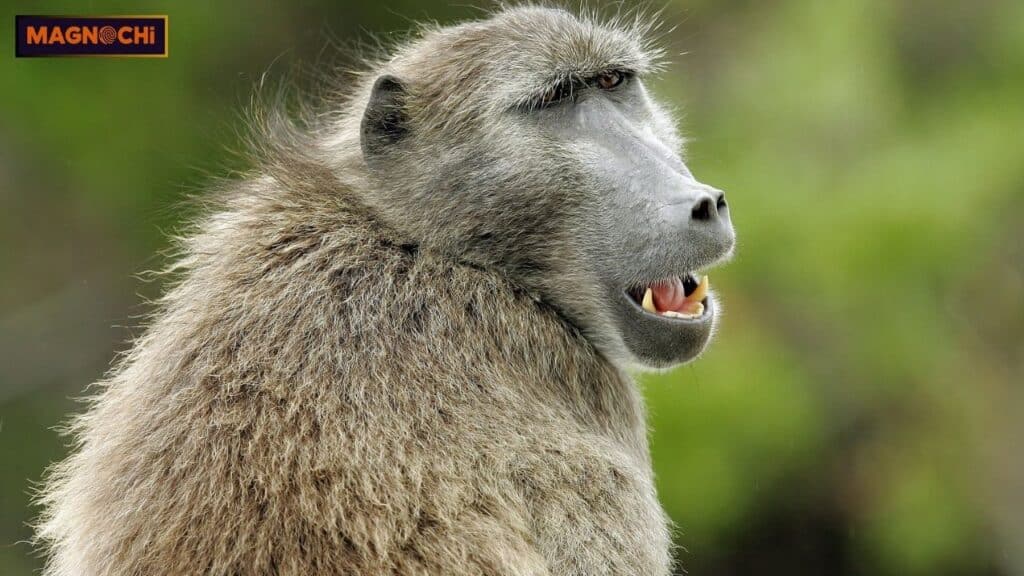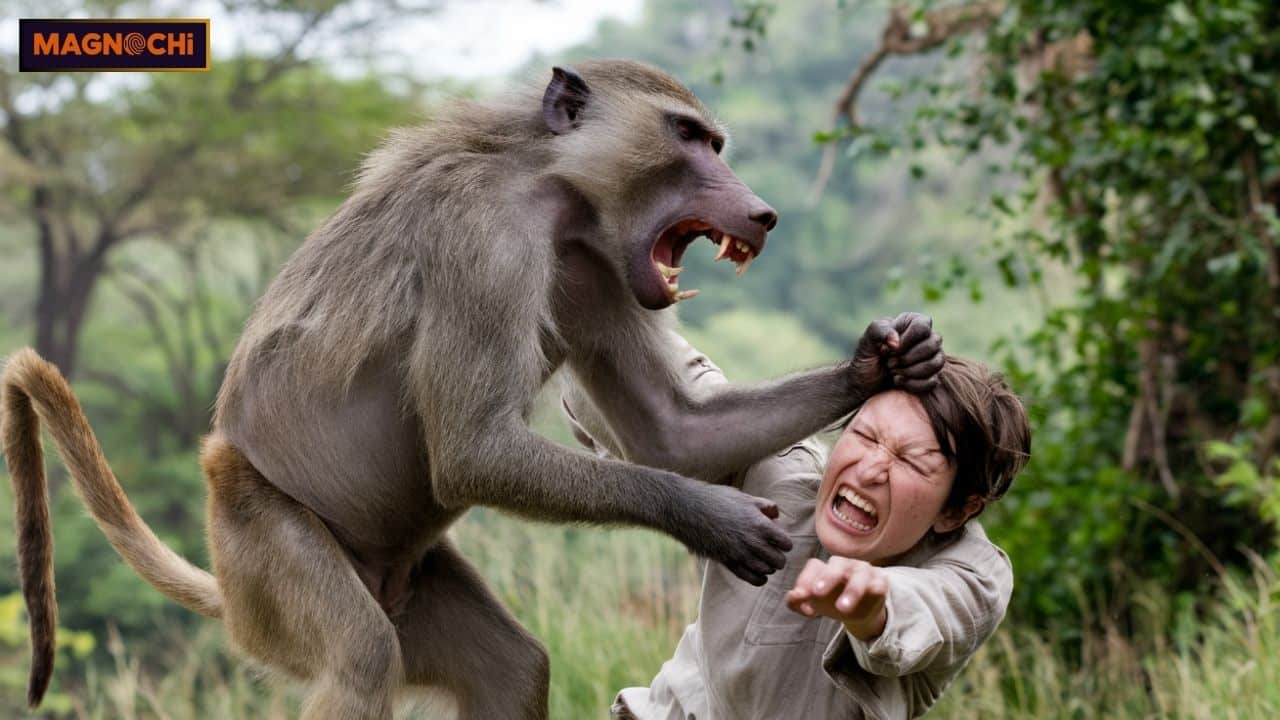Do Baboons Attack Humans? Baboons are among the most fascinating and intelligent creatures found in Africa. They have complex social structures, fascinating behavioral traits, and significant cultural importance.
However, despite their intelligence and intriguing behaviors, baboons can also become aggressive toward humans under certain circumstances. But how often do baboons attack humans? What triggers their aggression, and how can we avoid such encounters?
In this blog post, we’ll dive deep into the lives of baboons, uncover the reasons behind their aggressive behaviors, explore how dangerous these attacks can be, and provide actionable steps for staying safe in baboon-prone areas.
The goal is to answer the question: “Do baboons attack humans?” and, more importantly, how can humans coexist peacefully with these incredible primates?
What Are Baboons?
Baboons are large primates belonging to the genus Papio in the family of Old World monkeys. They are known for their social structures, intelligence, and adaptability to a wide range of environments. There are five distinct species of baboons:
- Chacma Baboons (Papio ursinus): Found mainly in southern Africa, Chacma baboons are one of the largest species, known for their strength and intelligence.
- Olive Baboons (Papio anubis): These baboons inhabit central and eastern Africa and are considered the most widely distributed baboon species.
- Yellow Baboons (Papio cynocephalus): These smaller baboons are found in the grasslands and savannas of eastern Africa.
- Guinea Baboons (Papio papio): A smaller species found in West Africa, Guinea baboons are more rare and live in forested areas.
- Hamadryas Baboons (Papio hamadryas): Found in the Horn of Africa and parts of the Arabian Peninsula, these baboons are known for their unique social structures.
Physical Characteristics of Baboons
Baboons have several notable features that make them well-suited for their environments:
- Size and Strength: Adult male baboons typically weigh between 40 and 100 pounds, with males being significantly larger than females. Their muscle mass makes them formidable in combat situations.
- Canine Teeth: Baboons have large, sharp canine teeth that they use for defense and aggression. These teeth are particularly useful in territorial defense and when protecting offspring.
- Facial Expression: Their faces are highly expressive, with bright coloration around the nose and cheeks that help convey emotions within their social groups.
- Prehensile Hands and Feet: These adaptations allow baboons to climb trees and handle food with precision.
Social Structure and Behavior
Baboons live in troops, which can consist of a few dozen to several hundred individuals. These troops are highly social, with complex hierarchies and social bonds.
Dominance hierarchies are established within the troop, with a dominant male leading the group, typically earning the right to mate with females.
Baboons are also known for their intelligence and problem-solving abilities, which are considered on par with other primates such as chimpanzees and gorillas.
They use tools, cooperate in foraging, and have advanced social systems that help them thrive in diverse environments, from savannas to urban areas.

Do Baboons Attack Humans?
The idea of baboons attacking humans can be a frightening one, but it is important to understand that baboons do not seek out human interaction.
Typically, baboon attacks occur in specific scenarios, especially in areas where humans and baboons come into close contact. [Do Baboons Attack Humans?]
Baboons tend to avoid humans in the wild, especially when they have access to abundant food sources and safe spaces. However, their behavior can change when they are forced to adapt to human-dominated environments.
The proximity of human settlements or urban areas to their natural habitats has increased in recent years, leading to more encounters between baboons and people.
Are Baboon Attacks Common?
While baboon attacks are not a daily occurrence, they are not rare, especially in urban areas or places where human-wildlife conflict is common.
The frequency of baboon attacks largely depends on the interaction between baboons and human activity. Tourist spots and regions with a high human population near baboon territories are more likely to witness aggressive behavior.
What Causes Baboons to Attack?
Understanding the factors that drive baboon aggression can help explain why attacks happen. Here are some of the most common reasons:
- Food Attractants: Humans often unintentionally attract baboons by leaving food out, whether it’s garbage, scraps, or unattended meals. In areas where food is scarce or hard to find, baboons will actively seek out food, even if it means engaging with humans.
- Territorial Defense: Baboons are territorial by nature, and they will aggressively defend their home range from perceived intruders. If a human enters their territory, especially during mating or feeding times, the baboon may attack to protect its space.
- Protecting Offspring: Female baboons are fiercely protective of their young. If they perceive a human as a threat to their infant, they will not hesitate to act aggressively. This behavior is especially common when humans accidentally wander too close to a mother with her babies.
- Provocation: Provocation is a leading cause of aggression in baboons. If a baboon feels threatened whether due to eye contact, sudden movements, or loud noises it may respond with aggressive behavior. Baboons are incredibly sensitive to body language and facial expressions, and what may seem harmless to a human could be interpreted as a threat.

Why Do Baboons Attack Humans?
Baboons’ aggressive behavior toward humans is often a defensive reaction rather than a predatory one. [Do Baboons Attack Humans?]
They are more likely to attack when they feel threatened or when certain triggers push them to defend themselves or their resources. Let’s break down the major reasons that drive baboons to attack humans.
Food Attractants
One of the main reasons baboons come into contact with humans is the presence of food. Urban areas often provide easy access to food sources such as trash, crops, and even food left behind by tourists.
When baboons become accustomed to finding food in human settlements, they may approach humans and become aggressive if they sense that food is being withheld or if they are competing for a food source.
- Example: In South Africa’s Kruger National Park, baboons are notorious for raiding campsites, stealing food from unsuspecting tourists. This type of behavior, driven by easy access to food, makes baboons more prone to aggressive encounters.
Territorial Defense
Baboons are highly territorial animals. They establish and defend home ranges that provide resources such as food, shelter, and mates.
When humans enter their territory, especially near their dens or feeding areas, baboons may interpret this as an intrusion and react with aggression to defend their space.
- Example: A Chacma baboon may feel threatened if humans enter its feeding territory during the dry season when food is scarce. In such a scenario, the baboon might charge at the humans or make aggressive vocalizations to protect its resources.
Protecting Offspring
Baboons are also very protective of their young, much like other mammals. If a human approaches a mother with her baby, the female baboon may see the human as a potential threat and attack to protect her infant.
This instinct is stronger during the early stages of motherhood, when a mother is particularly vulnerable and anxious about the safety of her baby.
- Example: A mother Olive baboon may charge a person who comes too close to her infant, especially if the infant is still nursing or in a vulnerable position.
Provocation or Threat Perception
Baboons have keen senses and are highly alert to changes in their environment. Sudden movements, direct eye contact, or unusual behavior can trigger a defensive reaction from the baboon.
It’s important to understand that eye contact can be seen as a challenge, and quick movements might be interpreted as a threat.
- Example: A tourist in Uganda’s Kibale Forest might unknowingly provoke a baboon by staring directly at it or making a loud noise. This can escalate into an aggressive interaction, where the baboon feels threatened and attacks.
Encroachment on Natural Habitats
Human activities, including deforestation, urbanization, and agriculture, have pushed baboons out of their natural habitats and into urban areas.
As baboons lose access to their traditional food sources, they are increasingly forced to venture into human spaces, which often leads to more frequent and potentially dangerous encounters.
- Example: In South Africa’s Cape Peninsula, baboons are frequently seen in urban neighborhoods, where they scavenge for food. As their natural habitats shrink due to habitat destruction, these encounters become more common.

Are Baboon Attacks Dangerous?
When baboons attack, the results can vary depending on the severity of the interaction and the response of the humans involved.
While baboon attacks are rarely fatal, they can still result in serious injuries and potential long-term health risks.
Potential Injuries from Baboon Attacks
- Bite Wounds: Baboons have strong jaws and sharp canine teeth, which they use to inflict deep puncture wounds. These bites can lead to infection and may require immediate medical attention.
- Claw Scratches: Baboons use their powerful hands to swipe at opponents. These swipes can cause deep lacerations and abrasions.
- Contusions and Bruising: A baboon may use its strength to physically overwhelm a human, causing bruising or contusions through aggressive physical gestures.
- Eye Injuries: Baboons are capable of causing severe eye injuries due to their sharp claws and biting capabilities.
Injuries from baboon attacks can lead to complications if not treated properly. Infection is a significant concern, especially if the bite punctures the skin deeply.
Rabies and other zoonotic diseases can also be transmitted through saliva or bites, which underscores the importance of seeking medical treatment immediately after any encounter.
How to Avoid Baboon Attacks?
While baboons are not inherently aggressive toward humans, certain behaviors can reduce the likelihood of an attack. [Do Baboons Attack Humans?]
If you live in or visit areas where baboons are common, follow these safety tips to minimize the risk of an aggressive encounter:
1. Never Feed Baboons
One of the most important rules when interacting with baboons is never to feed them. Feeding baboons encourages them to associate humans with food, making them more likely to approach and even become aggressive if they don’t get the food they expect.
2. Keep a Safe Distance
Always maintain a respectful distance from baboons. Do not attempt to approach them or get too close, especially if the baboons are with their young or appear to be feeding.
3. Avoid Eye Contact
Baboons view direct eye contact as a sign of aggression or dominance. It’s best to avoid making eye contact and remain as neutral and non-threatening as possible.
4. Stay Calm and Move Slowly
If a baboon approaches, remain calm and avoid sudden movements. Slowly back away from the baboon without turning your back, and do not run, as this could provoke the baboon to chase you.
5. Secure Your Food and Garbage
If you live in a baboon-prone area, make sure to secure food and garbage. Use bins with tight lids to prevent baboons from scavenging.
6. Use Barriers and Fencing
If possible, build fences or other barriers around your property to keep baboons out. Baboons are strong climbers, so make sure the barriers are tall and difficult to scale.
7. Carry Protection (Optional)
In rare cases, carrying pepper spray or a similar deterrent may be helpful if you are in an area with frequent baboon activity. However, it’s always best to avoid confrontation altogether.

Final Verdict
While baboon attacks are not a daily occurrence, they are a real and potential threat in areas where human and baboon habitats overlap.
However, most baboon encounters can be avoided by respecting these animals’ space and understanding their behavior. [Do Baboons Attack Humans?]
By following simple preventive measures, you can minimize the risk of human-wildlife conflict and coexist safely with these fascinating creatures.
FAQs
Are baboons aggressive towards humans?
Yes, baboons can be aggressive, especially if they feel threatened, protecting their young, or are searching for food. However, they typically avoid humans unless provoked.
What to do if a baboon approaches you?
If a baboon approaches, stay calm, avoid eye contact, and back away slowly. Do not run or make sudden movements as this might provoke it.
Have baboons ever killed humans?
Baboons rarely kill humans, but their powerful bites and aggressive behavior can cause serious injuries, especially if they feel threatened.
Can a human fight a baboon?
Humans are not strong enough to fight a baboon effectively. Baboons are powerful, and trying to fight one could lead to serious harm.
What is the most aggressive monkey?
The Hamadryas baboon is considered one of the most aggressive monkeys due to its territorial nature and protective behavior over its group.
Who would win a fight between a chimpanzee and a baboon?
In a fight, a chimpanzee would likely win. Chimpanzees are stronger, more intelligent, and have a greater ability to use tools compared to baboons.
What is a baboon afraid of?
Baboons fear predators such as lions, leopards, and hyenas. They also avoid unfamiliar or threatening situations that might jeopardize their safety.
What does it mean when a baboon shows its teeth?
When a baboon shows its teeth, it’s usually a sign of aggression or a warning. It’s a way for them to establish dominance or defend themselves.
Conclusion: Living Safely with Baboons
While the thought of baboons attacking humans is understandably alarming, it is important to remember that these animals are not inherently aggressive. Most baboon attacks occur due to human actions that unintentionally provoke the animals.
By understanding baboon behavior and following safety guidelines, we can coexist peacefully with these fascinating primates while minimizing the risk of conflict.
Baboons, like all wildlife, deserve respect and understanding. Whether you live in a baboon-prone area or are visiting a region where these creatures roam, taking simple precautions can ensure both your safety and the well-being of the baboons themselves.
Through awareness, responsible behavior, and mutual respect, we can reduce the likelihood of aggressive interactions and appreciate the complexity of these incredible creatures. [Do Baboons Attack Humans?]
Read more knowledgeable blogs on Magnochi









